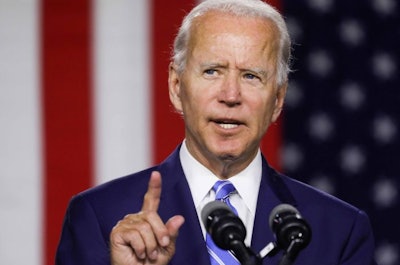
The White House says it will allocate US$1 billion to expand meat and poultry processing capacity in the U.S., as meat prices rise for consumers and production costs rise for producers.
In a fact sheet issued January 3, the White House said the meat and poultry processing sector is “a textbook example” of an industry with a lack of competition that hurts consumers, producers and the economy.
“When dominant middlemen control so much of the supply chain, they can increase their own profits at the expense of both farmers — who make less — and consumers — who pay more. Most farmers now have little or no choice of buyer for their product and little leverage to negotiate, causing their share of every dollar spent on food to decline,” the fact sheet said. “Fifty years ago, ranchers got over 60 cents of every dollar a consumer spent on beef, compared to about 39 cents today. Similarly, hog farmers got 40 to 60 cents on each dollar spent 50 years ago, down to about 19 cents today.
“Even as farmers’ share of profits have dwindled, American consumers are paying more—with meat and poultry prices now the single largest contributor to the rising cost of food people consume at home.”
In a virtual roundtable with farmers, President Joe Biden, Agriculture Secretary Tom Vilsack and Attorney General Merrick Garland detailed the administration’s Action Plan for a Fairer, More Competitive, and More Resilient Meat and Poultry Supply Chain. The action plan builds off of an executive order signed by Biden in July meant to promote competition in the economy.
The plan will dedicate US$1 billion in American Rescue Plan funds for expansion of processing capacity. After reviewing nearly 450 comments on how best to increase independent processing capacity, the U.S. Department of Agriculture identified the need to:
- Expand and diversify meat and poultry processing capacity
- Increase producer income
- Provide producers an opportunity to have ownership in processing facilities
- Create stable, well-paying jobs in rural regions
- Raise the bar on worker health, safety, training, and wages for meatpacking jobs
- Spur collaboration among producers and workers
- Prompt state, tribal and private co-investment
- Provide consumers with more choices
The White House also said it would issue new, stronger rules under the Packers and Stockyards Act and issue new “product of the USA” labeling rules.
In a statement, the American Farm Bureau Federation (AFBF) said it “appreciates the Biden administration’s continued work to ensure a fair and competitive meat processing system. We must get to the bottom of why farmers and ranchers continue to receive low payments while families across America endure rising meat prices.”
During the roundtable, one independent poultry processor said the dominant poultry production model in which large, integrated companies dictate the terms of restrictive contracts leaves growers with little control over their own operations and has laden them with debt, and that support for alternative business models and market structures can serve consumers, workers and producers.
In a report issued December 21, economists with Iowa State University, North Carolina State University and the National Pork Producers Council (NPPC), said pork prices, not industry profits, are rising due to increased transportation costs, supply bottlenecks and delays and increased labor costs throughout the pork chain. Other factors that have affected prices up and down the pork chain over the past 18 months, the report noted, include a 2.5% loss in pork packing capacity that resulted from a federal court order stopping faster harvesting line speeds, higher energy costs, rising feed costs and, most importantly, a shortage of workers, which has hindered productivity and caused wages to increase.
“This report shows there are numerous issues affecting pork prices, but increased profits, whether at the retail, wholesale, or farm level, are likely not a significant contributor to the rising prices,” said NPPC President Jen Sorenson in a statement. “Pork producers, for their part, are continuing to produce hogs to meet the strong demand for pork the industry has seen despite the pandemic.”
NCC, NAMI respond
Both the National Chicken Council (NCC) and the North American Meat Institute (NAMI) expressed skepticism and criticism over the administration’s announced plans.
“For the third time in six months, President Joe Biden and his administration announced the same plans to spend $1 billion to fund government intervention in the market in an attempt to increase prices livestock producers receive while blaming inflation on private industry,” said Julie Anna Potts, NAMI president and CEO. “The Biden Administration continues to ignore the number one challenge to meat and poultry production: labor shortages. This tired approach is not surprising because they have refused to engage with the packing and processing sector they attack, going so far as to hold a roundtable on meat packing without a single beef or pork packer present.
“Press conferences and using taxpayer dollars to establish government-sponsored packing and processing plants will not do anything to address the lack of labor at meat and poultry plants and spiking inflation across the economy,” said Potts.
NCC President Mike Brown said he had not yet seen Biden’s proposal, but said at this point, it appears to be a “solution in search of a problem.”
“The vast majority of chicken farmers are thriving helping to produce America’s number one protein. In fact, chicken companies have waiting lists of potential family farmers that want to partner with them and enter into the chicken business,” said Brown.
“The chicken industry is the least consolidated in all of animal agriculture, and the market share of the top four companies has been virtually the same for the past 20 years. “It’s time for The White House to stop playing chicken with our food system and stop using the meat industry as a scapegoat for the significant challenges facing our economy. This administration should be looking at the chicken industry as a model of success, instead of creating a boogeyman to justify an unnecessary and expensive foray into our meat supply.”

















